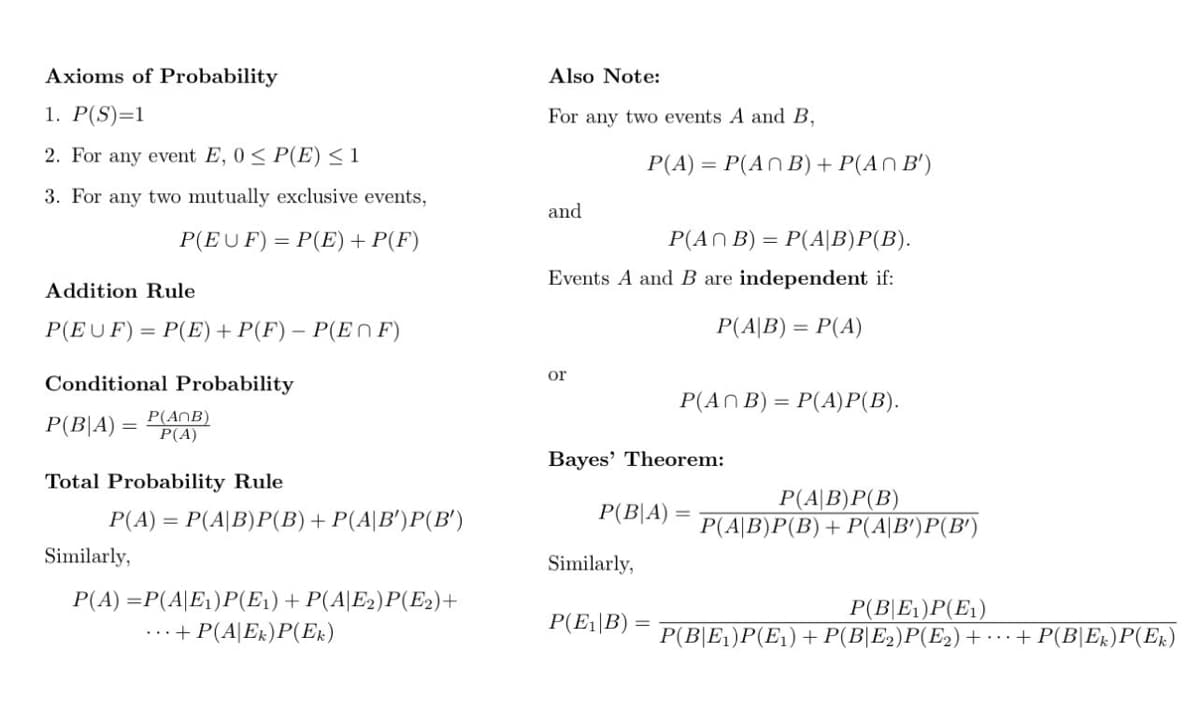2) A randomly chosen moviegoer purchases a soda but not po p) A randomly chosen moviegoer purchases a soda or popcorm c) A randomly chosen moviegoer does not purchase anything.
2) A randomly chosen moviegoer purchases a soda but not po p) A randomly chosen moviegoer purchases a soda or popcorm c) A randomly chosen moviegoer does not purchase anything.
Holt Mcdougal Larson Pre-algebra: Student Edition 2012
1st Edition
ISBN:9780547587776
Author:HOLT MCDOUGAL
Publisher:HOLT MCDOUGAL
Chapter11: Data Analysis And Probability
Section11.8: Probabilities Of Disjoint And Overlapping Events
Problem 2C
Related questions
Question
Please answer correctly and show all your work. Attached is the formula sheet you can use.

Transcribed Image Text:For each of the events described below, provide an expression using events A and B; and compute their
respective probabilities.
(a) A randomly chosen moviegoer purchases a soda but not popcorn.
(b) A randomly chosen moviegoer purchases a soda or popcorn.
(c) A randomly chosen moviegoer does not purchase anything.

Transcribed Image Text:Axioms of Probability
Also Note:
1. P(S)=1
For any two events A and B,
2. For any event E, 0< P(E) < 1
P(A) = P(AN B) + P(AN B')
3. For any two mutually exclusive events,
and
P(EUF) = P(E)+ P(F)
P(AN B)
P(A|B)P(B).
Events A and B are independent if:
Addition Rule
P(EUF) = P(E)+ P(F) – P(EnF)
P(A|B) = P(A)
or
Conditional Probability
P(AN B) = P(A)P(B).
Р(BJA) —
P(ANB)
P(A)
Bayes' Theorem:
Total Probability Rule
Р(A В)P(В)
Р(А|B)Р(В) + Р(A|B')P(В')
P(A) = P(A|B)P(B)+P(A|B')P(B')
P(B|A)
Similarly,
Similarly,
P(A) =P(A|E1)P(E1) + P(A|E2)P(E2)+
...+ P(A|Ek)P(Ek)
P(B|E1)P(E1)
P(B|E1)P(E1) + P(B|E2)P(E2) + · .+ P(B|ER)P(Ex)
P(E1|B)
Expert Solution
This question has been solved!
Explore an expertly crafted, step-by-step solution for a thorough understanding of key concepts.
This is a popular solution!
Trending now
This is a popular solution!
Step by step
Solved in 2 steps with 2 images

Recommended textbooks for you

Holt Mcdougal Larson Pre-algebra: Student Edition…
Algebra
ISBN:
9780547587776
Author:
HOLT MCDOUGAL
Publisher:
HOLT MCDOUGAL

College Algebra
Algebra
ISBN:
9781305115545
Author:
James Stewart, Lothar Redlin, Saleem Watson
Publisher:
Cengage Learning

Holt Mcdougal Larson Pre-algebra: Student Edition…
Algebra
ISBN:
9780547587776
Author:
HOLT MCDOUGAL
Publisher:
HOLT MCDOUGAL

College Algebra
Algebra
ISBN:
9781305115545
Author:
James Stewart, Lothar Redlin, Saleem Watson
Publisher:
Cengage Learning